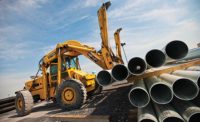Industrial PVF industry puts up caution flag
Industry thought-leaders see varying degrees of slowdown, focus remains on internal improvement.

Industrial PVF executives are noticing varying degrees of slowdown in the space. “We anticipate the market will be slower for the next six months,” Wolseley Industrial Group Vice President Rob Braig says. “The good news is we still anticipate the PVF market to grow at a low-to-mid-single-digit growth rate the following year.” Photo courtesy of Ferguson.

Charles D. Sheehy President Jeff Camuso uses the word ‘nimble’ to describe the distributor’s current mindset. “You need to be able to look at all supply channels and quickly modulate between them,” he says. “When new technologies and processes gain momentum in the marketplace, you need to ask, ‘How can my company get involved with this?’” Photo by Mike Miazga/Supply House Times.

Hiring and attracting up-and-coming talent remains a key focus for industrial PVF companies. “Our associates are our greatest assets and we invest to attract, develop and train the industry’s best talent,” WIG’s Braig says. Photo courtesy of Ferguson.



The industrial pipe, valves and fittings industry is applying the brakes when it comes to talk about the near future. While companies in that patch continue to report positive returns, industry insiders are predicting varying degrees of slowdown ahead.
“We anticipate the market will be slower for the next six months,” Wolseley Industrial Group Vice President Rob Braig says. “The good news is we still anticipate the PVF market to grow at a low-to-mid-single-digit growth rate the following year. Our expectation is for a soft landing rather than a recession.”
Braig notes customer activity, for the most part, remained strong in 2018, but at the beginning of 2019, “the industrial PVF marketplace started to lag across all industries. The decrease in activity mirrors the reduction in project work. There’s no one reason why the project work has declined, so even though activity has slowed, that’s against tougher comps from last year. As people begin to feel secure again, we expect project work to pick up.”
Rob Raban, president of Southern California-based master distributor Industrial Valco, puts the oil-gas-fueled PVF market in a separate bucket from industrial PVF activity right now. “I would say in general the industrial PVF market is flat,” he says. “The oil/gas market has slowed considerably, perhaps down 5-10%. This is a head-scratcher in my opinion because the price of oil seems to be holding steady in the mid- to upper $50s. The economy is doing well and interest rates are low. I’m not quite sure why we’re having the slowdown we are in the oil/gas PVF segment.”
Alan Lipp, COO of Ohio-based manufacturer/master distributor Merit Brass, also has seen some curious market fluctuations. He calls the current situation “some wacky times.”
“From our vantage, raw materials prices have been weighed down by trade actions and the uncertainty related to the degree and duration of tariffs,” he says. “We believe this has negatively impacted market demand levels for products of Merit.
“Interestingly, as of this writing, nickel, which drives 300 series stainless steel cost levels, was on the rise. This has caught many of us by surprise. Nickel normally follows the general price directions of copper, other industrial metals and oil. While these commodities have remained at relatively low levels, nickel has increased markedly since the beginning of July, and there may very well be sustained improvement to its fundamentals. With that said, all the above factors run counter to historical patterns and make predicting the short- to mid-term price outlook of stainless steel piping products exceptionally difficult.”
Tariff talk
Merit’s Lipp mentions the tariff topic, one that remains front and center in this marketplace. “Customers’ buying habits have switched to short-term thinking,” Midland Industries Chief Marketing Officer Billy Hodes says. “Smaller orders more often, in hopes the tariffs will be rescinded soon.
“I’m curious to see when the tariffs are rescinded, how fast it translates into lower market prices.”
Kip Miller, president and CEO of South Carolina-based Eastern Industrial Supplies, sees the brunt of the tariffs issue heading toward the rear-view mirror. “We are still concerned, but think the majority of disruption is behind us,” he says. “Our customers understand tariffs and have accepted price increases. The remaining unknown is what will be the impact on the market when and if the tariffs are withdrawn.”
Pennsylvania-based manufacturer Penn Machine still sees tariffs as “a major concern,” President Joe Pro says. “The tariffs were being imposed on steel and aluminum to support U.S. steel producers,” he says. “In fact, the U.S. steel mills have increased their plant utilization and are bringing more capacity online. Prices had risen on domestic carbon steel when the tariffs were imposed. This led to increased costs that have been passed along in the form of higher prices for finished goods. There are numerous grades of steel that are no longer produced in the United States, and those costs all have increased with the added tariffs imposed.
“Our outlook has not changed. The trade discussions with China, Japan, Mexico and Canada are more political theater than actual business strategies. We don’t see a quick end that improves the market conditions.”
Keeping the focus at home
While uncertainty and oddities swirl in the PVF winds, executives interviewed for this story are keeping keen focuses on their businesses and developing processes and initiatives aimed at fortification for the long run.
And at the top of that industry to-do list is labor. “It remains difficult to find new employees,” American Pipe & Supply CEO John Howe says. “We understand things always are changing no matter what industry you are in. We will continue to focus on developing our people. We feel like this is the most important component of our long-term success.”
Jomar Valve Vice President Adam Stier says attracting and retaining quality people is the Michigan-based manufacturer’s highest priority. “We are growing quite rapidly and our search for quality, impactful employees who make a difference in our daily business is a continuous cycle for us,” he says.
The Collins Companies President Brian Tuohey says his Connecticut-based distributorship also is on the hunt for up-and-coming talent. “We are focused on acquiring and better-connecting with a younger workforce, improving the digital experience that we make available to connect with our customers, and by being proactive in engaging with and possibly acquiring companies looking for an ‘exit strategy,’” he says.
The shift into more digitally focused ways of doing business continues to gain steam in this space as well. “We will need to continue to be more sophisticated in how we convey products to customers,” says Jeff Camuso, president of Boston-area-based distributor Charles D. Sheehy. “It’s important that we understand our place in the marketplace and don’t take it for granted. In order to remain valuable and insightful partners to our clients, we must continue to be where they are.”
Jomar’s Stier says the lion’s share of the company’s business still comes via brick and mortar. However, he notes Jomar is very cognizant of customers’ changing buying habits. “We see, feel and hear what is going on with e-commerce,” he says. “Jomar always has been keen on leveraging technology to improve our service levels to our customers. Therefore, we offer EDI, ASNs, an e-commerce portal, and other technologies for our distributor partners.”
In general, despite a lot of craziness and uncertainty, companies throughout the PVF supply chain are making additional adjustments to make sure they continue to win business in their marketplaces — particularly when it comes to customer service.
“Midland always is working intimately with our customers to improve efficiency and convenience throughout the sales cycle by developing customer-driven solutions, smart technology, and deep product selection,” Hodes says.
Jeff Shreiner, vice president of sales at Michigan-based manufacturer Legend Valve, says the company continues to play to its industry strength — over-the-top service. “We continue to invest in ways to take cost out of the distribution chain,” he says. “Our goal every day is to WOW the customer. We ship 85% of our orders out the same day we receive them, and continue to have a 98.5% fill rate, and we make less than one-half of 1% errors on orders. We can do this because our owners are committed to investing in technology and our people. We have invested in our information and distribution systems, our customer service tools, internet information, as well as manufacturing technologies for our PERT tubing division. We want to be the low-cost provider for the products we sell. We always have our customers’ backs.”
Industrial Valco’s Raban notes his company continues to focus on operational excellence and delivering on its brand promise of “Speedability,” meaning in-stock, error-free and in two hours or less with orders.
“We can’t control the ups and downs of the market, so we’re just trying to be the most reliable supplier we can in service to our distributor customers.”
Eastern’s Miller and Sheehy’s Camuso use terms such as nimble and agile to describe their thought-processes going forward.
“It’s the alignment of our organization around the existing opportunities to improve profitability by focusing on financial fitness metrics, innovation and organizational improvement,” Miller says. “Our focus has shifted from 12-moth planning to 12-week plans, allowing us to be more agile, responsive and entrepreneurial. We have expanded our decision-making team for greater collaboration to help uncover answers to questions we don’t even know to ask yet — all before making decisions such as adding new locations, new sales verticals, new capital expenditures, etc.”
Camuso adds; “We use the word ‘nimble.’ You need to be able to look at all supply channels and quickly modulate between them. When a government action comes down, you need to make quick decisions to protect your clients. You need to have good instincts and trust them when selecting new products. When new technologies and processes gain momentum in the marketplace, you need to ask, ‘How can my company get involved with this?’”
Looking for a reprint of this article?
From high-res PDFs to custom plaques, order your copy today!












